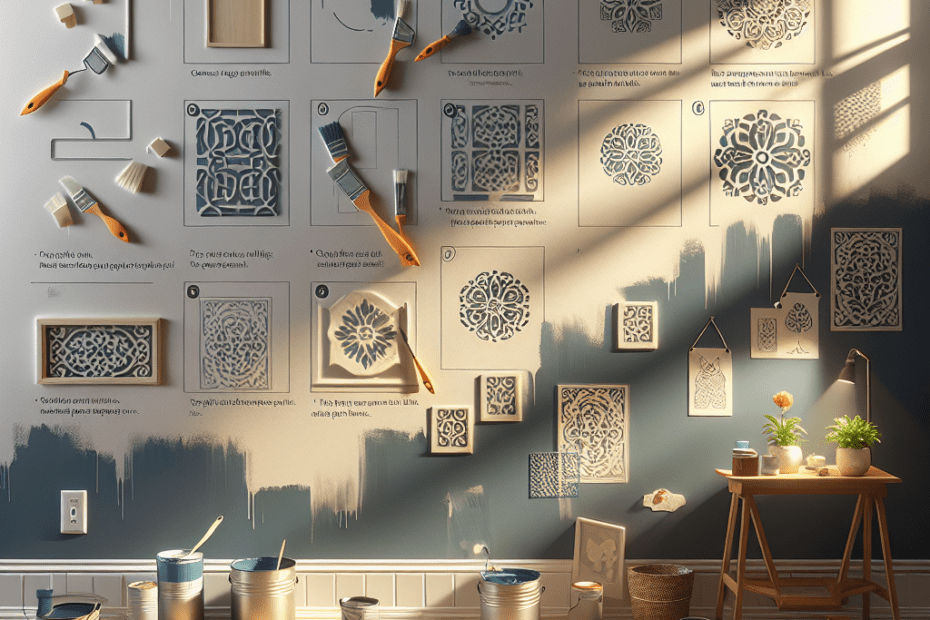“`html
Introduction
Many people, when looking to refresh their living space, often turn to creative yet manageable projects. One such project is creating a DIY stenciled accent wall. This fun and transformative task can bring uniqueness to any room without the need for a complete overhaul. As reported by the Houzz 2023 Interior Design Trends Study, 45% of homeowners cited improving aesthetics as the primary reason for home renovations. Painting and stenciling present a budget-friendly way to achieve a fresh and stylish look.
Materials and Preparation
The first step in creating a stunning DIY stenciled accent wall is gathering the necessary materials. Essential items include:
- Painter’s tape
- Level
- Stencil of choice
- Paint roller or stencil brush
- Base coat paint and stencil paint
- Drop cloth
- Sandpaper
- Pencil
- Tape measure
Preparation is key. They need to start by ensuring the wall surface is clean and smooth. Washing the wall and sanding any rough patches will help paint adhere better. A solid base coat is crucial to achieving a professional look. Allow the base coat to dry completely before proceeding to stencil.
Choosing and Placing the Stencil
It’s beneficial to pick a stencil design that complements the room’s overall style. Geometric patterns, floral prints, or classic damask designs are popular choices. Once a design has been chosen, it’s time to decide on the stencil’s placement. They should use a level and a pencil to lightly mark where each stencil will go. This planning step will ensure the pattern remains straight and centered.
Painting the Stencil
| Task | Tips |
|---|---|
| Tape the Stencil | Ensure the stencil is securely taped to prevent movement. |
| Applying Paint | Use light, even coats to prevent bleeding or blurry edges. |
| Frequent Checks | Regularly step back to check the pattern alignment and coverage. |
With the stencil securely taped, they can begin to paint. Using a stencil brush or a small foam roller with minimal paint will reduce the risk of paint bleeding under the stencil. Applying paint in light, dabbing motions ensures cleaner lines. It’s recommended to peel away the stencil slowly while the paint is still tacky to avoid peeling paint off with it.
Finishing Touches
Once they have completed stenciling, inspect the wall for any imperfections. Touching up these areas with a small brush helps maintain the finished look. After the wall has fully dried, which may take up to 24 hours, applying a clear sealant can protect the stenciled pattern and make it more durable.
Benefits of a DIY Stenciled Accent Wall
Creating a stenciled accent wall is not just about aesthetics. It’s an opportunity to incorporate personality and artistry into a living space. According to a 2023 National Association of Decorating Professionals survey, a creatively designed space can increase a home’s value by up to 15%. Furthermore, the satisfaction derived from completing a DIY project can enhance emotional well-being.
Key Takeaways
- Proper preparation of the wall is critical for successful stenciling.
- Using light, consistent pressure when painting will yield the best results.
- Regular inspections during the painting process ensure precision and cleanliness.
- DIY stenciled accent walls offer economical yet effective aesthetic improvements.
- Such projects can enhance both real estate value and personal satisfaction.
FAQ
- What types of paint work best for stenciling?
Acrylic or latex paint is recommended for stenciling because of their quick-drying properties and easy cleanup. - How do they correct stencil mistakes?
Lightly sanding or painting over mistakes can correct imperfections. Always allow the area to dry before reattempting the stencil. - Can stenciling be done on textured walls?
Yes, but it’s more challenging. Using thicker, textured stencils and applying paint with a stencil brush is more effective on textured walls. - Are stenciled walls easy to maintain?
Yes, applying a clear topcoat sealant makes the surface easier to clean with a damp cloth without damaging the design. - How large should they make the pattern?
The stencil pattern size should be proportional to the wall and space. Large patterns suit expansive walls, while smaller patterns are ideal for more confined areas.
“`
